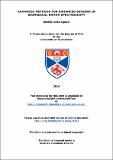Advanced methods for enhanced sensing in biomedical Raman spectroscopy
Abstract
Raman spectroscopy is a powerful tool in the field of biomedicine for disease
diagnosis owing to its potential to provide the molecular fingerprint of biological
samples. However due to the inherent weak nature of the Raman process, there is a
constant quest for enhancing the sensitivity of this technique for enhanced diagnostic
efficiency. This thesis focuses on achieving this goal by integrating advanced methods
with Raman spectroscopy.
Firstly this thesis explores the applicability of a laser based fluorescence
suppression technique – Wavelength Modulated Raman Spectroscopy (WMRS) - for
suppressing the broad luminescence background which often obscure the Raman peaks.
The WMRS technique was optimized for its applications in single cell studies and tissue
studies for enhanced sensing without compromising the throughput. It has been
demonstrated that the optimized parameter would help to chemically profile single cell
within 6 s. A two fold enhancement in SNR of Raman bands was demonstrated when
WMRS was implemented in fiber Raman based systems for tissue analysis. The
suitability of WMRS on highly sensitive single molecule detection techniques such as
Surface Enhanced Raman Spectroscopy (SERS) and Surface Enhanced Resonance
Raman Spectroscopy (SERRS) was also explored. Further this optimized technique was
successfully used to address an important biological problem in the field of immunology.
This involved label-free identification of major immune cell subsets from human blood.
Later part of this thesis explores a multimodal approach where Raman
spectroscopy was combined with Optical Coherence Tomography (OCT) for enhanced
diagnostic sensitivity (>10%). This approach was used to successfully discriminate
between ex-vivo adenocarcinoma tissues and normal colon tissues.
Finally this thesis explores the design and implementation of a specialized fiber
Raman probe that is compatible with surgical environments. This probe was originally
developed to be compatible with Magnetic Resonance Imaging (MRI) environment. It
has the potential to be used for performing minimally invasive optical biopsy during
interventional MRI procedures.
Type
Thesis, PhD Doctor of Philosophy
Rights
Creative Commons Attribution-NonCommercial-NoDerivatives 4.0 International
http://creativecommons.org/licenses/by-nc-nd/4.0/
Embargo Date: 2018-03-18
Embargo Reason: Thesis restricted in accordance with University regulations. Print and electronic copy of chapters 6 and 8, [Vol. 2], restricted until 18th March 2018
Collections
Except where otherwise noted within the work, this item's licence for re-use is described as Creative Commons Attribution-NonCommercial-NoDerivatives 4.0 International
Items in the St Andrews Research Repository are protected by copyright, with all rights reserved, unless otherwise indicated.


